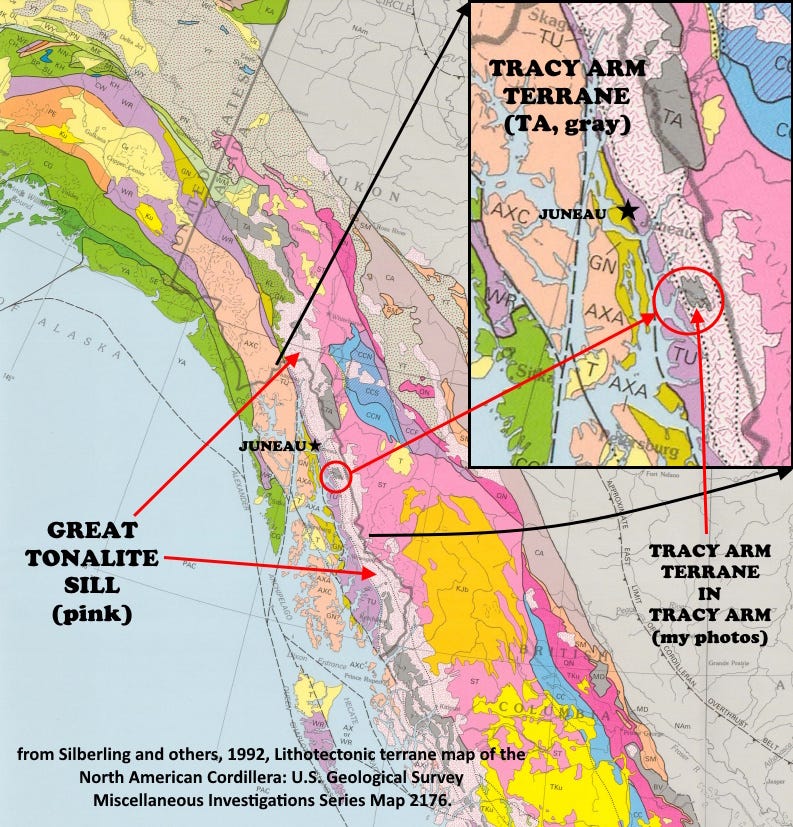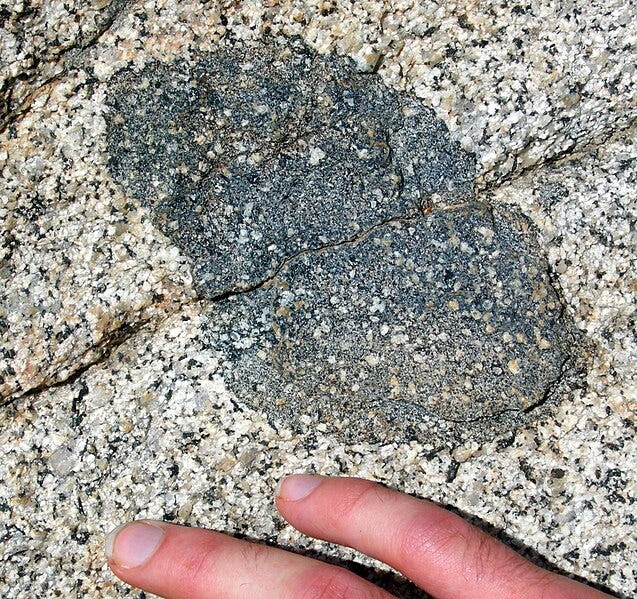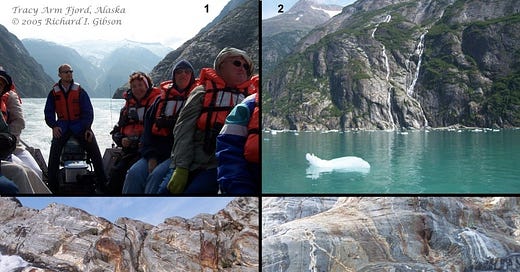Life in the USA is not normal. It feels pointless and trivial to be talking about small looks at the fascinating natural world when the country is being dismantled. But these posts will continue, as a statement of resistance. I hope you continue to enjoy and learn from them. Stand Up For Science!
Tracy Arm is a glacial fjord on the coast of Alaska south of Juneau. Its rocks are part of the Coast Ranges, a complex suite of accreted terranes. In part because of the remaining glacial cover as well as high mountains and difficult access, the rocks in this region are poorly understood.
In geology a terrane is a discrete body of rock that records a specific geologic and tectonic history that is distinct from adjacent terranes (which is why they are sometimes called “exotic” terranes). They are typically fault-bounded, have been tectonically transported from sometimes great distances, and may have been accreted, amalgamated, to each other at diverse times, as well as to a major craton, or continental core. Terranes may be crustal fragments – either oceanic or continental – or island arcs, or some other material; the key thing is that within them they maintain a consistent history, differing from other terranes.

Much of the panhandle of Alaska contains a long (1,000 km) narrow (25 km) body of intrusive igneous rock called the Great Tonalite Sill. Tonalite is a rock that’s almost granite, but it contains less alkali (potassium and sodium) feldspar than true granite, so some categorizer gave it a different name. The Great Tonalite intrusive is thought to be a sill – meaning an intrusive that is concordant with (sides parallel to) the things it intrudes – because for all that 1,000-km length, it pretty closely approximates the boundary between two terranes, discrete bodies of rock with different histories that became attached (accreted) to North America over a long span of time, say 120 million to 60 million years ago. The tonalite sill either came in later along the linear boundary, or it may have been coeval with the development of the terrane boundary when the boundary might have been a complex shear zone (Ingram and Hutton, 1994, The Great Tonalite Sill; emplacement into a contractional shear zone and implications for Late Cretaceous to early Eocene tectonics in southeastern Alaska and British Columbia: GSA Bulletin 106(5):715-728). The age of the tonalite and intrusive granitic rocks in the region is about 50 to 70 million years.

Whatever the Great Tonalite Sill’s backstory, when you look at a terrane map of Alaska, it sure looks like another terrane – the Tracy Arm Terrane – is incorporated into the sill and other intrusives like gigantic xenoliths, bodies of “strange rock” that get included within the molten stuff that intrudes them. On the map above, the gray patch in the red circle is part of the Tracy Arm Terrane surrounded by the Great Tonalite Sill.
The chunks of the Tracy Arm Terrane are scattered through the Coast Ranges of Panhandle Alaska and adjacent parts of Canada for nearly the same 1,000 km that the tonalite is found. The one small bit of the Tracy Arm Terrane in Tracy Arm itself is only about 10 x 25 km in size, and it’s completely surrounded by the igneous rocks, just like a big xenolith. There may be some other explanation, but this one seems simplest to me.
My photos show 1) our trip up the fjord in a Zodiac on a Smithsonian Journey for which I got to be the geological study leader; 2) the gray tonalite that occupies most of the walls of the fjord; and 3) and 4) the extremely deformed rocks of the Tracy Arm Terrane. Since I was on a small boat (and trying to answer questions for 10 or 12 tourists), I couldn’t exactly analyze those outcrops, but some of it looks to me as if it’s really close to being a migmatite – a rock that has been heated up so much that it partially melts.
In any case, the origins of the rocks in the Tracy Arm Terrane (3 and 4 in the photos) are diverse and poorly understood. The high-grade metamorphic rocks include a wide range of rock types dominated by marble, gneiss, and quartzite, with minor serpentine. The best guess for the origin is as a continental shelf block of Late Proterozoic (600 to 1000 million years ago) sediments and volcanic rocks. They contain detrital zircons of Mesoproterozoic and Archaean age, which supports the idea that they were deposited in Late Proterozoic time (Pecha et al., 2016, Detrital zircon U‑Pb geochronology and Hf isotope geochemistry of the Yukon-Tanana terrane, Coast Mountains, southeast Alaska: Geosphere 12(5): 1556). *WHERE* they were deposited is even less well known, but perhaps somewhere on the margin of the continental blocks that constitute China today.
For a lot more information about the Tracy Arm Terrane, see Currie, 1994, The geology and mid-Jurassic amalgamation of Tracy Arm terrane and Stikinia of northwestern British Columbia: Ph.D. thesis, Carleton University.





You bring back memories - as a near teenager I got to visit Tracy Arm on a small, 100 passenger cruise ship in 1964.